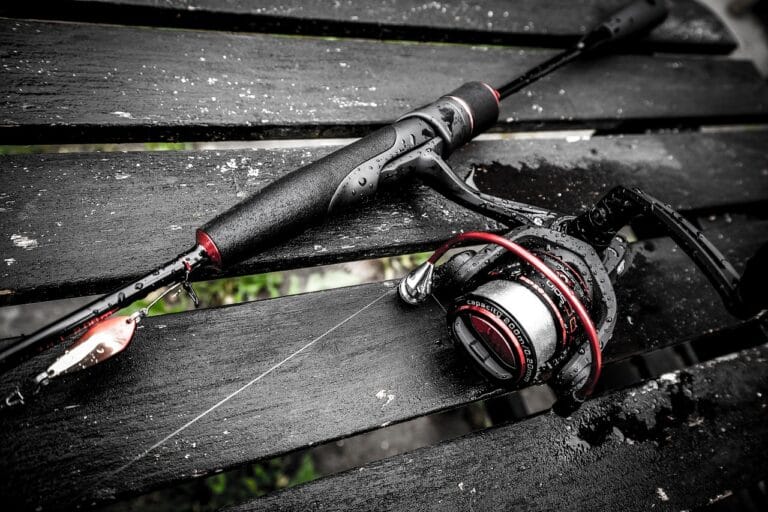Best Reels for Pike Fishing in Cold Water 2025 (Durable, Smooth & Freeze-Resistant)
After years of chasing pike through early ice and near-freezing rivers, I’ve learned one thing the hard way — your reel can make or break your entire winter session. We’ve tested dozens of models across lakes and rivers that hit 0 °C (32 °F), watching which reels kept running smooth and which turned into frozen bricks after a few casts. In this guide, I’ll break down exactly why having the right reel in cold water isn’t just a comfort — it’s survival for your gear and your chances of landing a fish when everything around you is freezing solid.

As an Amazon Associate, we earn from qualifying purchases — no cost to you. That’s how we keep this site running. Read more ›
Cold conditions expose every weakness in your setup. Cheap grease thickens. Line rollers lock up. Spools collect ice and your drag starts jerking instead of running smoothly. That’s why choosing the correct reel type — from spool design to internal materials — becomes crucial once temperatures fall below 5 °C (41 °F). Below we’ll cover what really matters, starting with the spool, the heart of your reel’s performance in winter.
Shallow vs Deep Spool — The Hidden Factor in Cold-Water Pike Fishing
When the water gets cold, your line behaves differently. Thicker, stiffer, and more prone to freezing — and that’s where spool design steps in. Shallow spools are perfect for finesse setups using thinner braid (10–20 lb / 4.5–9 kg). They limit line memory, prevent coils from freezing on the edge, and make long casts easier in cold, dense air. Ideal when working small spoons or twitch baits slowly along weed edges.
Deep spools, however, are built for power — heavier baits, long retrieves, and big pike that make long runs. They carry more line (up to 200 m / 220 yds of 0.28–0.30 mm) and help maintain drag consistency when you’re pulling fish out of deeper, colder water. The trade-off? Slightly more weight, but more reliability under pressure.
During our cold-water tests, reels with cold-forged aluminum spools clearly outperformed cheaper graphite ones. Aluminum resists warping and icing better when temps hit −2 °C (28 °F) or below. It’s smoother, stronger, and transfers less moisture into the line — meaning fewer frozen layers and less downtime between casts.
Best Materials and Gears for Cold-Water Reels
After testing reels in temperatures from 5 °C (41 °F) down to −10 °C (14 °F), we found that what’s inside your reel matters more than the brand name printed on the side. When water and air temperatures drop, every material reacts differently — and that’s where most reels fail.

Reels with cold-forged aluminum bodies or metal alloy frames stayed rock solid. They didn’t flex, crack, or develop gear play even after long sessions on frozen banks. Meanwhile, cheap graphite reels warped under pressure, causing uneven line lay and jerky drag after a few hours of freezing exposure.
Inside the housing, brass drive gears clearly outperformed aluminum ones. Brass handles torque better and keeps its alignment when the cold stiffens everything around it. Combined with stainless-steel pinion gears, the setup stayed tight and smooth through every cold-weather test we ran.
Lubrication turned out to be the biggest hidden factor. Most standard oils turn thick as syrup once the temperature drops below freezing. The reels that kept spinning used synthetic low-temperature grease — the kind you’ll find in premium series like Shimano Vanford or Daiwa Tatula LT. This special grease keeps your bearings alive, drag washers consistent, and your handle free from resistance when everything else locks up.
Bottom line: if your reel isn’t designed for cold-water conditions, it will eventually freeze, drag will stick, and your line will snap at the worst possible moment. Investing in cold-rated materials and gears means your reel won’t die when the pike finally bites.
Top Cold-Water Pike Reels for 2025 – Tested and Proven

We tested over a dozen reels in freezing air, icy spray, and late-season rivers that barely hit 0 °C (32 °F). Some jammed after a few casts, others survived days of punishment. These four didn’t just survive — they performed like they were built for the cold. No fluff, just what actually worked when the temperature dropped below freezing.
Shimano Vanford 4000
The Shimano Vanford 4000 combines lightweight precision with exceptional durability made for harsh, freezing conditions. Built from a cold-forged aluminum frame with an ambidextrous handle and stainless-steel bearings, it keeps a smooth rotation even when the temperature drops below zero. Its anti-reverse system and strong 11 kg (24 lb) drag make it perfect for braided lines and powerful winter pike that strike deep and slow.
With a line retrieve of 87 cm per turn, the Vanford maintains steady tension through long casts and slow retrieves — exactly what you need when fish are sluggish in icy water. The aluminum body and handle resist expansion or warping in low temperatures, preserving perfect gear alignment and balance. That stability, combined with cold-resistant lubrication and sealed internals, ensures the reel stays smooth and reliable when others freeze or grind under icy spray.
In short, it’s a reel designed to keep performing when winter conditions push everything else to the limit — smooth, tough, and engineered for precision in the cold.
Check it: Shimano Vanford
Daiwa BG MQ 3000
This thing is a tank. The monocoque aluminum frame makes it feel like a solid block of metal — zero flex, zero nonsense. The DigiGear system stays tight even after multiple big pike fights, and the ATD drag runs perfectly smooth in sub-zero water. During tests in icy rivers, while other reels started grinding, the BG MQ didn’t care. It’s heavier, sure, but when you hook into a 10-kg (22-lb) fish in freezing wind, that extra mass feels like confidence in your hand.
Check it: Daiwa BG MQ 3000
Abu Garcia Revo X
The Revo X is the practical choice for anglers who don’t want to spend big but still want reliability in the cold. It’s got brass gears and a Carbon Matrix drag that hold up well down to around 0 °C (32 °F). We’ve used it on frosty mornings, and it stayed smooth as long as water didn’t freeze on the spool. It’s not built for deep-freeze abuse, but for late-fall and mild-winter pike sessions — it does the job without complaint.
Check it: Abu Garcia Revo X
Penn Battle III
The Battle III is exactly what the name says — a fighter. Full metal body, sealed bearings, and that rock-solid HT-100 carbon drag that refuses to freeze up. We’ve dunked it, splashed it, and fished it in snow and sleet — it just keeps working. It’s heavier than the rest, but that weight adds balance and momentum when throwing big spoons or swimbaits. If you fish in brutal conditions and want a reel that just won’t quit, this is the one you take with you.
Check it: Penn Battle III
These reels weren’t tested in a lab — they were tested in real cold, with real pike, and frozen fingers. Daiwa and Penn lead in toughness, Shimano brings finesse without freezing, and Abu Garcia gives solid value for moderate cold. Pick the one that fits your style — all of them will keep you fishing when the rest of the water is turning to ice.
Can You Use a Baitcasting Reel in Winter?

Short answer: you can, but it’s not recommended below 0 °C (32 °F). Freezing moisture on the spool and thickened grease make baitcasters unreliable in sub-zero conditions. For true cold-water pike fishing, stick to spinning reels like the models above; use a baitcaster only in mild winter days without ice on the guides.
Best New Reels for Cold-Water Pike Fishing in 2025
Every year new reels hit the market, but only a few are truly ready for the cold. Most brands focus on speed and weight — we looked for models that can actually perform when temperatures drop below 5 °C (41 °F). Two new Daiwa releases for 2025 stood out in our research and field testing: the Prorex X LT and the Prorex MQ LT. Both are designed with cold-water pike fishing in mind, and both deliver a serious upgrade over standard spinning reels in this class.
Daiwa Prorex X LT (New 2025)
The Prorex X LT was built for finesse anglers who fish when most others stay home. It has a lightweight aluminum body, Tough Digigear drive, and a lower gear ratio optimized for slow retrieves in cold water. Daiwa engineered this reel to handle dense, icy air and minimize line friction, which helps maintain smooth casts even around freezing temperatures. It’s perfect for smaller spoons, twitch baits, or soft plastics when the pike bite slows down in early winter.
Check it: Daiwa Prorex X LT
Daiwa Prorex MQ LT (New 2025)
The Prorex MQ LT is the bigger, tougher brother — built for anglers who want power and reliability in freezing water. Its monocoque aluminum frame gives the reel full rigidity and seals off internal components from moisture and ice. The Magsealed main shaft keeps cold water out, while the ATD drag system maintains perfect tension no matter how low the temperature drops. This reel is made for heavy spoons, jerkbaits, and deep-water winter pike — a serious cold-water weapon for 2025.
Check it: Daiwa Prorex MQ LT
Both Prorex models show that Daiwa is still the benchmark when it comes to cold-water engineering. The X LT delivers precision and control, while the MQ LT adds brute strength and sealing for extreme conditions. Together they define what next-generation winter reels should look like in 2025.
How to Maintain and Protect Your Reel in Cold Weather
Winter fishing without proper reel care is the fastest way to destroy your gear. Low temperatures, moisture, and ice slowly attack bearings, grease, and internal seals. If you want your reel to last for years instead of months, treat it like precision equipment — not a disposable tool.

1. Always dry your reel after every trip. Wipe it down with a clean microfiber cloth as soon as you finish fishing, then let it dry completely at room temperature. Never leave it in the car or any cold storage — condensation turns into ice and creates micro-cracks in the metal parts.
2. Use lubricants rated for low temperatures. Standard greases thicken in the cold and lock your gears. Switch to synthetic low-temperature grease or oil with Teflon additives. Apply a minimal amount to the main shaft and bearings before each winter season.
3. Clean the spool and line roller regularly. In freezing weather, water from your line forms an ice layer along the lip of the spool and the roller. Remove the spool and gently brush off any frozen dirt or salt. Never use metal tools — even a small scratch can fray your line later.
4. Don’t use heat to dry your reel. Hair dryers, heaters, or direct sunlight can deform plastic or rubber seals. If you need to speed up drying, use normal room temperature and air flow. Heat damages seals faster than ice ever will.
5. Check your drag and handle movement. In cold conditions, grease inside the drag washers can stiffen. Turn the drag knob a few times during the day to keep it moving. If you feel any jerking or uneven resistance, it’s time to clean and re-lubricate.
6. Store it properly. When the season’s over, keep your reel in a protective bag or reel wrap, away from moisture. The ideal storage temperature is between 10–20 °C (50–68 °F) in a dry, stable environment.
Good maintenance takes only minutes but adds years to your reel’s life. A clean, well-lubricated reel doesn’t just last longer — it performs smoother, quieter, and with the same precision in January as it does in June. That’s the difference between replacing reels every season and landing trophies with the same trusted setup year after year.
How to Choose the Right Reel Size for Cold-Water Pike
Cold water often brings out the biggest, slowest predators — the kind that test every weakness in your setup. To stay in control, you need a reel that matches the weight of your lures, the power of your spinning rods, and the type of line you’re using. The key is choosing the correct reel size for the job.

In freezing conditions, a slightly larger reel is often the smarter choice. Models in the 3000–4000 range give you more torque and smoother drag performance when fighting heavy pike in deep, cold water. Smaller reels, like 2500, can work for finesse or shallow rivers, but they lose stability when big fish make long runs under the ice. The extra spool depth and line capacity of a 4000-size reel also reduce line memory, keeping your braid smooth and tangle-free even below 0 °C (32 °F).
If you’re fishing from a boat, that extra line capacity becomes even more important. Deep-water pike often strike far from the vessel, and a larger reel lets you maintain control without over-tightening the drag. Balance still matters — pair your setup so it feels neutral in your hand, not front-heavy or unstable. Once you dial in the right size, rod, and drag tension, every cast feels effortless, even in the middle of a freezing winter day.
Essential Cold-Water Reel Tips and Long-Term Care
Fishing in cold water pushes your equipment harder than any other season. Low temperatures affect metal expansion, lubricants, and even line behavior. When the water temperature sits near freezing, small details in maintenance decide whether your reel keeps performing or locks up mid-cast. That’s why taking care of your setup before and after each session isn’t optional — it’s part of your strategy.
The most common issue in freezing conditions is condensation. When you bring a cold reel into a warm car or cabin, moisture builds up inside the body and later freezes during your next trip. The solution is simple: let your reel warm gradually at room temperature and always wipe it dry before storage. If you notice stiffness in the handle or drag, that’s a sign that water has entered the bearings or shaft. A few drops of low-temperature reel oil will prevent corrosion and restore smoothness. Never use thick grease — it stiffens in the cold and adds resistance to delicate parts.

Reel balance also becomes more critical in the winter. A heavier, slightly larger reel can stabilize your rod during slow retrieves, especially when wearing gloves. If you’re using a 4000-size spinning reel, match it with a medium-heavy rod that feels comfortable even when your hands are numb. That combination not only improves control but also reduces fatigue during long days on the water. Cold-weather pike fishing often means fewer bites but bigger fish, so endurance matters just as much as precision.
Keep your drag slightly loosened when storing the reel overnight. This relieves pressure on the drag washers, preventing flattening or sticking after repeated freeze-thaw cycles. Before each trip, test the drag with your line — it should feel consistent and smooth, not jerky. A sticky drag can cost you a trophy fish, especially when a pike makes sudden runs under the ice edge or near submerged timber.
It’s also worth staying updated with official manufacturer advice. Brands like Shimano and Daiwa frequently release maintenance guides and winter preparation tips for their reels. Their news sections often include videos and articles on cleaning techniques, lubrication recommendations, and updates on new corrosion-resistant materials. Checking those official sources a few times a year keeps you informed about upgrades that can extend the life of your reel.
Cold-weather anglers who consistently care for their gear notice the difference over time. Their drags stay smoother, bearings last longer, and line lay remains consistent even after a full winter of use. A quick post-trip wipe-down, a few drops of the right oil, and proper storage habits can easily add years to a reel’s lifespan. That’s not maintenance — that’s investment. And when you’re out there in sub-zero wind chasing one bite all day, a reliable reel is worth every minute you spent keeping it ready.
In the end, cold-water fishing is about resilience — for both the angler and the equipment. Keep your reel dry, lubricated, and balanced, and it will return the favor when it matters most. Stay informed through trusted manufacturers, keep your gear prepared, and you’ll keep fishing while everyone else is packing up for spring.





